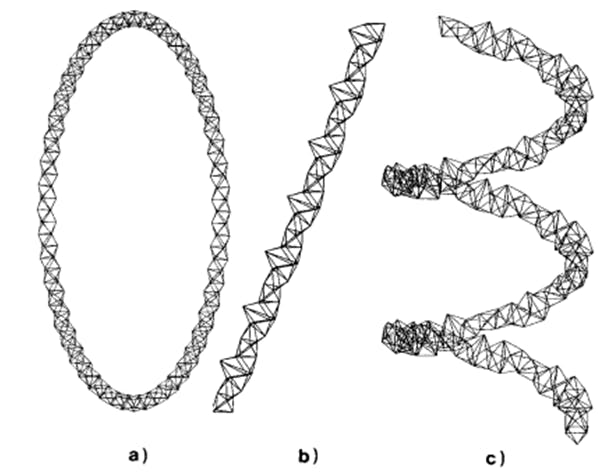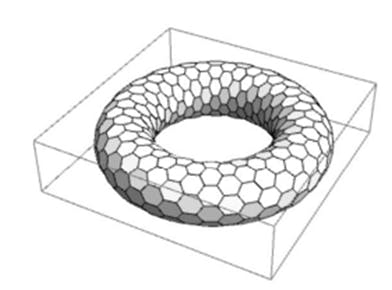Dyson sphere, the space elevator, the construction of a space station inside an asteroid – all such ideas seem feasible in the foreseeable future, as we are accustomed to extrapolating the successes already achieved in the construction of space stations. The era of inhabited space orbital stations began in 1971.
Today, we will touch on an automatic assembly and docking of orbital modules to create space habitats of arbitrary shape. In 2018, the Massachusetts Institute of Technology launched the TESSERAE project, described as “self-assembling space architecture.” I will post a promotional video for this program below, but first I would like to note that dreams of such space architecture were formulated in Japan as early as 1988.
Background. Adaptive farms.
In 1988, Hiroshi Furuya of Nagoya University and Korio Miura of the Japan Aerospace Exploration Agency suggested how the assembly and superstructure of space stations could be automated, gradually transforming them into space settlements. They also addressed issues of deployment, docking, and sealing of compartments, and investigated the role of microgravity in both the assembly and operation of such an adaptive modular station.
To ensure the adaptability of such a structure, it must be equipped with a mechanism for changing its own configuration. A “linear” analogue of such a structure would be a conventional multi-link manipulator that bends according to the Rubik’s snake principle. However, such a structure lacks rigidity and will quickly become loose in low gravity. In a one-dimensional case, in order to obtain an effective and lightweight structure, it must be topologically similar to a spatial truss. This is how Miura and Furuya imagined such “linear” trusses with an adaptively changing shape:
Under what conditions would such a set of trusses be adaptive? One option is if any element of the structure could change its length without affecting the length of other elements and without increasing the internal stress of the entire system. This condition is feasible if the entire truss is statically determinate.
When deploying and gradually building up a space station, the most attractive feature of an adaptive system is that the system itself controls its own assembly. The elastic and vibration properties of both individual trusses and their assemblies will inevitably depend on the configuration of the entire station. When selecting a configuration, it is most important to optimize the stiffness and fundamental frequencies of the structure. This applied discipline is already called “elastic adaptability.”
However, the aforementioned Japanese study focused specifically on openwork extended structures. It is unlikely that such trusses, even comparable in strength to carbon nanotubes, could be used to build closed interconnected compartments that would remain airtight while allowing the structure to be expanded by wedging new blocks into the existing structure.
Kori Miura (born 1930) continues this research and is the co-author of the classic Cambridge book Forms and Concepts for Lightweight Structures. I believe that it was his work that inspired Ariel Ekblaw’s group. Ekblaw is leading the development of self-assembling modules at MIT as part of the TESSERAE project, which could eventually serve as the basis for a new generation of space stations. Like fullerenes, tesserae consist of pentagons and hexagons, but theoretically they can be assembled into structures much more complex than a dodecahedron or a soccer ball, such as a torus.
Let’s talk about them in more detail.
The TESSERAE project
So, to deploy the orbital settlements of the future, humanity will need self-assembling, adaptive, expandable (additive), and inflatable structures. Since orbital engineering designs are not constrained by Earth’s gravity, completely new options for shells and tiers can be explored there. Earth architecture is traditionally vertically oriented (floors, walls, ceilings, arches, elevators) and requires significant resources to be spent not so much on usable space as on load-bearing structures. Autonomous space assembly, together with simultaneous digital printing and pre-printing of blocks, will make it possible to do without conveyors, blocks, and, of course, lifting cranes. By printing the necessary blocks in geostationary orbit, it would be possible to significantly reduce the volume of payload launched into orbit, and by borrowing construction materials from asteroids moored at Lagrange points, the payload mass could also be reduced.
Possible exterior view:
Inside view of the module:
This project is called TESSERAE (Tiled Electromagnetic Space Structures for Exploring Reconfigurable Adaptive Environments). Currently, the MIT team is testing and assembling prototypes (shown here are samples measuring 13 inches in diameter):
To ensure predictability of assembly, it is necessary to standardize the dimensions of individual tiles, as well as the geometry of polygons to obtain macrofigures. Naturally, equilateral and equiangular (regular) polyhedrons are the obvious choice for this purpose, but given that the structure must remain stable during repairs and when new blocks are added, the three-dimensional structure of this type is similar in shape to a fullerene.
By definition, the edges of the structure must differ in terms of function. It is assumed that each module will have at least four types of edges: opaque cover (walls), transparent cover (windows), magnetic (docking), and sensory. It may also be necessary to provide for a fifth category—solar panels. The customization of the interior of the modules and compartments will likely be even more diverse.
In order to simulate the assembly line construction of the station, the modules could be launched into a predetermined orbit. Traveling in this orbit around the Earth or the Moon, the structure would pick up the blocks and materials prepared for it at predetermined points.
Electromagnets ensure that the plates are autonomously captured with each other and form closed polygons. Since the plates have a pronounced hexagonal shape, the entire structure may well resemble not only a fullerene, but also a parallelepiped or cube, resembling honeycombs:
3D printing and magnets
The main difficulty of such an assembly lies in coordination. Each plate must act as a separate agent of the swarm.
The most convenient way to obtain tiles for TESSERAE is by 3D printing. This will result in rigid plates (pentagonal or hexagonal) with specially cut holes for permanent magnets (EPM) on each edge. The module is equipped with:
- Motherboard that controls the electrical circuits for moving the modules;
- Wireless communication with a remote control center (main computer);
- Motion sensors, thanks to which the tiles do not collide with each other but gently dock;
- Inertial measurement unit (IMU) that allows tracking the relative position, rotation, and change in orientation of the tiles.
It is also planned to provide connectors on the tiles for installing peripheral devices. The most important of these are a magnetometer (for detecting electromagnetic contact and diagnosing the communication signature between docked tiles) and a paired emitter and light detector (in RGB color scheme) for exchanging data between tiles using photonics.
Naturally, the operation of the EPM will depend entirely on the data received from the sensors. In addition, the EPM will be the main consumers of energy and will require an uninterrupted power supply. The polarity of the EPM will also need to be constantly adjusted so that the structure does not disintegrate, but at the same time does not collapse into an undesirable or catastrophic form, and does not end up in a metastable state.
We are currently only learning the basics of 3D printing in space, but this technology is a real investment in the future. It is obvious that when exploring the solar system, we will have to work in conditions of greatly reduced gravity. This applies to Martian colonies, the potential development of minerals on asteroids, and, even more so, the colonization of Lagrange points. The basis for such technology can be not only experiments in 3D printing on board the ISS, but also additive manufacturing, which is quite feasible under Earth’s gravity.
Unlike many modern (rigid) orbital structures, tessera tiles can be tightly packed before being launched into open space, easily replaced, and assembled. In addition, given the magnetic coupling, such structures can be not only assembled but also disassembled automatically.
Here we will dwell a little more on the role of magnets and the similarity between TESSERAE assembly and additive manufacturing. Given that each magnet operates autonomously and the entire structure exhibits the characteristics of a swarm of robots, it is possible not only to change the polarity of the magnets, but also to simply disable individual magnets for a short time. This gives the structure additional optional degrees of freedom, and in microgravity conditions, it can turn into a quasi-stochastic system.
In this case, modularity is combined with reconfigurability, so the entire structure can be quickly reassembled to meet changing expedition requirements and new tasks, or to remove damaged or depressurized elements.
The initial assembly may take place not in open space, but in a special inflatable container optimized for the shape of a fullerene. This container can be docked to a space station, from where the initial set of tiles is loaded into the container and ensured to take the target configuration. This is what a habitable orbital station assembled in the form of a fullerene might look like (the MOSAIC project for operation in Mars orbit, the acronym stands for “Mars Orbiting Self-Assembling Interlocking Chambers”).
Internal structure
Let’s move on to the most interesting part: how realistic is it to make such a station habitable without it being astronomically expensive?
The internal cavity of the self-assembling fullerene should be equipped with lightweight and automatically deployable structures that would not pose a threat to the crew (for example, would not overheat) and would leave maximum space for living and working, as well as for storing equipment, food, water, and air. Take a look at the configuration of the planned American lunar station Lunar Gateway, which is currently scheduled for launch in 2027:
It is assumed that a crew of eight people will work at such a station for three months. What would a similar station made of fullerene blocks look like?
The most important factor in designing such a station is the size of the airlock between compartments, and in Gateway, the airlock diameter will be 93 cm. Accordingly, all objects and devices must fit through this opening. For comfortable living on the TESSERAE station, there must be a dining room, bathroom, washroom, sleeping quarters, meeting rooms, and work areas. At least a quarter of the space must be allocated for storage, and 30% of the space for air circulation.
Living module
One astronaut’s personal space occupies three hexagons with free access to a fourth hexagon equipped for communication and collaboration. The areas for storing personal belongings are shown in blue and green. In addition to the portholes, the entire inner surface of the walls is available for covering with LCD panels displaying media information.
In principle, almost all elements of the capsule’s interior should be foldable or telescopic, possibly inflatable.
Conclusion and a little more about sensors
Once again, I would like to note that both the external and internal surfaces of the blocks can be simply studded with various sensors, forming a kind of “smart compartment.” While the external sensors are responsible for the assembly process (dynamics) and maintaining the correct configuration (statics), the internal sensors could record the level of radiation, the content of harmful impurities in the air, and also signal potential depressurization. The unit could be equipped with dual-purpose sensors, such as spectroscopic sensors, which could be used both for laboratory purposes and as a life support element.
The development of such sensors requires the development of a completely new technology of functional fibers that combine the capabilities of sensors, telecommunications devices, and batteries. Nevertheless, it is precisely the conditions of microgravity, vacuum, and the desire for maximum compactness of all elements that are conducive to the development of such technologies, which on Earth would seem exotic or of little practical use.
I doubt that TESSERAE will be deployed in orbit (including near the Moon or Mars) by the end of this decade. However, I believe that “acceptance testing” of all these ambitious developments — at least in the form of miniature prototypes — is a priority task for the crews of new orbital stations, especially Tiangong.



















